INTRODUCTION
Colombia is worldwide one of the cacao bean producers of the “fine flavor cacao” with high quality beans and linked to origin (CBI, 2020). More than 190,000 ha of land were dedicated to the cacao crop in 2018, of which 5,100 ha were cultivated in the department of Cundinamarca (Agronet, 2020). About 98 % of the cacao in the country is cultivated by small and medium growers of low income (Escobar et al. 2020): the cultivated private lots are small (1-5ha), the trees frequently require renovation and are lacking adequate agricultural practices results in low yields (Fedecacao, 2020). Nevertheless, this crop might have a significant impact on the national economy, considering that Colombia is the center of the genetic origin of cacao (Osorio-Guarín et al. 2017). Cacao has high social importance; it is one of the crops most important in the post-conflict period (Montañez et al. 2019). It is part of the “Cacao for peace” programs focused on the replacement of illicit crops and the generation of rural employment (Cely Torres, 2017).
Production of organic cacao is an emerging new trend in Colombia, focusing on the bean´s export to international markets specialized in organic cacao. Associated with lesser yields (Florida et al. 2020), organic cacao cultivation does not allow the use of synthetic chemicals, involves sustainable management of natural resources, and may offer beans of superior quality. This aspect should be especially taken into account, since cadmium (Cd) can be absorbed by cacao plants in certain amounts (Rodríguez Albarrcín et al. 2019) where soils contain Cd of natural origin. This limits the use of conventional mineral fertilizers in cacao, assuming that the application of mineral fertilizers further increases Cd accumulation in beans. According to the EU regulations such as Commission No. 488/2014, the maximum level of Cd should not exceed 0.8 mg kg-1 and, in some cases even 0.1 mg kg-1 (Diario Oficial de la Union Europea, 2014). Moreover, the high cost of mineral fertilizers for small growers is an additional challenge for using organic fertilizers in cacao.
In Colombia, small growers frequently receive little technical assistance and they use traditional artisanal practices of cacao cultivation (Cely Torres, 2017; Fedecacao, 2020) resulting in low production. At the same time, adequate fertilization and pruning (Vanhove et al. 2016; Niether et al. 2018; Riedel et al. 2019) are essential to achieve sustainable production in cacao. In the cultivation of organic cacao, pruning can be an efficient practice to prevent plant diseases because it allows more light to enter the tree canopy and prevents an increase in relative humidity (Babin, 2018), taking into account that numerous pathogens, including Monillia sp. and Phytophthora sp., affect cacao production in Cundinamarca (Fedecacao, 2020).
Practices for organic cacao cultivation are emerging in the country as compared with traditional crop management practices. In Colombia, few studies on the effects of organic fertilization on cacao growth and production are available (Álvarez-Carrillo et al. 2015). Thus, the effects of organic amendments and pruning as techniques of crop renovation, on crop yield, and on pod morphometry remain practically unstudied.
The objective of this study was to evaluate the effect of pruning and organic fertilization on cacao (Theobroma cacao L.) yield. These treatments were assessed as management alternatives that might improve cacao yield in old plantations (trees older than 20 years) lacking technical assistance. If found beneficial in terms of yield, the fertilization and pruning could serve as cheap, simple, and ecofriendly practical recommendations for small growers for increasing organic cacao yields.
MATERIALS AND METHODS
Experimental area and plant material. This research was done in Nilo municipality located in the alto Magdalena region (4°18′25″N, 74°37′12″W) of Cundinamarca, Colombia. The area corresponds to the tropical dry forest (bs-T) (Holdridge, 1967) with 26.5 °C average air temperature, 31.6 ºC maximum temperature, 21.4 ºC minimum temperature, 66 % relative air humidity, and mean annual precipitation of 1292 mm. The precipitation regime in the region has a bimodal distribution. During the experiment, the monthly precipitation in the municipality was 102.5-163.7 mm (February-May, a rainy period) and 78.4 mm (June, a dry period), with air temperatures varying within the mentioned baseline values.
The experiment was established in the Nápoles farm (4°21'14.22"N, 74°32'33.75"W) of 5 ha extension, located at 336 m a.s.l. and focused on organic cacao production. This farm belongs to Proasoagro, an association of organic cacao producers in Cundinamarca (Proasoagro, 2020). The cacao trees planted in the area corresponded to CCN51, TSH565, and local hybrids of up to 24 years old. The planting density was 820 plants ha-1. The crop did not have supplemental irrigation. The soil was Typic Eutrudepts-typic Udorthents, with pH 6.2, 5.6 % organic matter, 0.49 % N contents, and 20.7 and 5.3 meq/100g contents of Ca and Mg.
Experiment design and treatments. The following four treatments were evaluated in a completely randomized design:
1) Control without fertilization or pruning; 2) Pruning (P) treatment. This was established according to the recommendations of Fedecacao and consisted of elimination most parts of secondary and tertiary branches on the trees to minimize branch overlapping, and to reduce tree height to 3-3.5 m; 3) Organic fertilization (OF); 4) Pruning + organic fertilization (P+OF).
Each treatment had 3 spatial replicates (plots). Each of the 12 experimental units corresponded to a plot occupied with approximately 30 cacao plants. In each plot, 10 plants were marked with a plastic tape and assessed for chlorophyll contents, fruit morphometry, and yield, of a total of 120 trees.
Pruning and fertilizer application were done three months before the first harvest. Doses of organic fertilizers were suggested based on soil analysis in the area and cacao crop requirements (ICA, 1992). The fertilizer sources were the products employed in organic cacao production according to the Proasoagro, approved by the association and that did not have restrictions for use. The following fertilizers were applied:
1) Compost, prepared by the producer according to the Proasoagro (Proasoagro, 2020), with organic topsoil, chicken manure, coffee husk, plantain pseudostem, legume biomass, all at equal weight, as a source of N, mainly N-NH4 + form; 2) Patentkali, a source of potassium free of chlorine and composed of 100 % soluble potassium and magnesium sulfates, this fertilizer was obtained from mines through physical processes that allow its use in organic agriculture and contained 30 % K2O, 10 % MgO, and 42.5 % water soluble sulphates; 3) EPSO Top, a magnesium sulfate used as a source of magnesium and sulphur and certified for use in organic agriculture; 4) Rock phosphate, a product obtained from the mine extraction and used as the main source of phosphorus for the plants; 4) Arbuscular mycorrhizae (Safer brand).
The organic fertilizers were applied at the following rates per plant: 1250 g compost, 30 g Patenkali, 17 g rock phosphate, 37 g mycorrhizas, and 18 g EPSO Top. To fertilize each tree, the litter was removed around each tree, leaving a circle of about 150 cm around the trunk. Subsequently, the fertilizers were applied to the soil and covered with a small amount of soil and litter.
Relative chlorophyll content in leaves. Assessed at the beginning (March 28, 2017) and at the end (June 18, 2017) of the harvest period, using the Spectrum chlorophyll meter Fieldscout CM 1000 (Spectrum Technologies, Inc., Aurora, IL, USA), which calculates the chlorophyll index. In each tree, the measurements were made on 4 fully expanded leaves located on the opposite side of the crown. From these 4 measurements on each sampling date, the chlorophyll meter generated a single value of the relative contents.
Pod morphometry and bean yield. The harvest of ripe pods was carried out on 4 occasions in March, April, May, and June 2017. The following variables were obtained per tree and pods: number, length, and middle circumference, determined with measuring tape (cm); total fresh weight (g); fresh weight and number of beans per pod (g); yield of dry beans (g DW).
The harvested beans were placed into plastic nets and fermented with mucilage according to local practices. For this, the beans were deposited in the wooden fermentation boxes, and the temperature was monitored, indicating the opportune moment to end the drying process when the beans reached 7 % humidity.
Statistical analysis. With the data obtained, tests of normality (Shapiro-Wilk) and homogeneity of variances (Levene's test) were performed. The variables that did not meet these assumptions were transformed by square root. Subsequently, an analysis of variance and an LSD test (p <0.05) were carried out for the separation of means on each sampling date. SPSS V. 19 statistical software was used. Additionally, the correlations between the selected variables were assessed using nonparametric Spearman test.
RESULTS AND DISCUSSION
Relative chlorophyll content. No significant differences in the relative chlorophyll contents between the treatments were obtained in March (first harvest), but statistical differences were detected in June (last harvest) (Figure 1). In June, the highest chlorophyll content was observed in the treatment with organic fertilization (OF) and the lowest one with the pruning (P) treatment (Figure 1).
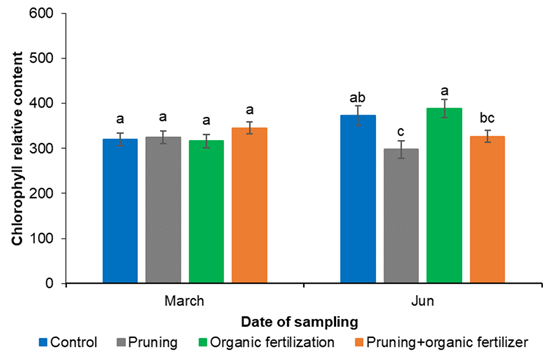
Figure 1 Effect of organic fertilization and pruning on the relative chlorophyll content in leaves of cacao plants in Nilo (Cundinamarca). Averages followed by different letters on each sampling date show statistical differences according to the LSD test (p <0.05). Vertical bars indicate the standard error (n=3, where n is a plot of 10 plants).
In cacao, the chlorophyll levels in leaves may or may not correlate with the yield (Zakariyya & Prawoto, 2015; Medauar et al. 2018). Establishing whether the chlorophyll content correlates with the yield has practical importance and would allow using chlorophyll contents to predict the yield or growth variables. Thus, Zakariyya & Prawoto (2015) found a positive correlation between the chlorophyll contents in leaves and pod yield. The contents of chlorophylls a, b, and total (a+b) were positively correlated with bean number and weight; at the same time, the contents of total (a+b) chlorophyll had high genetic variance and high phenotypic variance among the cacao genotypes (Anita-Sari et al. 2015). No relationship was evident between the relative chlorophyll contents in leaves and cacao yield in Brazil (Medauar et al. 2018).
In our study, the relative chlorophyll contents in leaves correlated positively with the number of pods per tree at the beginning of the harvest period (R=0.625), while at the end of the harvest period this correlation was negative (R=-0.618) (Table 1). In other studies, the negative correlation with cacao yield was found for foliar concentrations of N, P, and Cu, which was explained by the high nutritional demand for these nutrients in the productive phase of cacao (Marrocos et al. 2020). More than 50 % of leaf N could be a part of the chlorophyll molecule; therefore, a significant reduction in the chlorophyll contents in leaves could indicate a re-translocation of N from leaves to the growing fruits (Pilbeam, 2015), which could further result in a negative correlation between the fruit number/weight and the leaf chlorophyll contents.
Table 1 Spearman correlations between the relative content of chlorophyll (CHL) and the total number of pods, total fresh weight of pods and dry weight of cacao beans harvested from cacao plants in Nilo (Cundinamarca) during March-June of 2017.
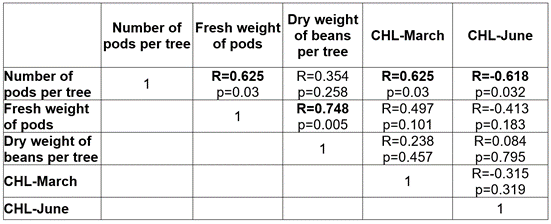
In June, the effect of pruning on chlorophyll contents was more evident, with lower levels of chlorophyll obtained in the treatments with pruning (P and P+OF) (Figure 1). The low contents of chlorophyll at the end of the harvest period in pruned plants could be attributed to nutrient recycling from leaves to pods or to the intensive formation of new leaves (the sinks for N and C) after pruning. This tendency was not present in other treatments, which could be due to the lower nutrient demand in non-pruned plants (the control) or the additional nitrogen supply from the fertilizers (OF treatment). The reduction in chlorophyll level in leaves at the end of the harvest period (June), apparently, marked the reduction of the tree nutrient reserves at the end of the harvest, suggesting nutrient recycling to the fruits from senescing leaves (Figure 1).
Although tree shading is an important condition for increasing photosynthetic rates in cacao (Agudelo-Castañeda et al. 2018), pruning practices are essential for the renovation of old trees (Vanhove et al. 2016). The positive effect of pruning on yield, among others, could be due to reducing the incidence of the frosty pod rot (Moniliophthora roreri) (Riedel et al. 2019), a common disease of cacao in the Americas.
Pod number and morphometry. Statistical differences (p <0.05) between the treatments in the number of pods per tree were observed in April, May, and June. The total number of recollected pods also varied according to the treatment (Figure 2). The pruning plus organic fertilization (P-OF) generated the highest number of pods by the end of the harvest period. In control plants, the total number of pods produced by one tree during 4 months was 9.5 pods, while, in the treatment P-OF, the total number of pods was 13.3 (Figure 2).
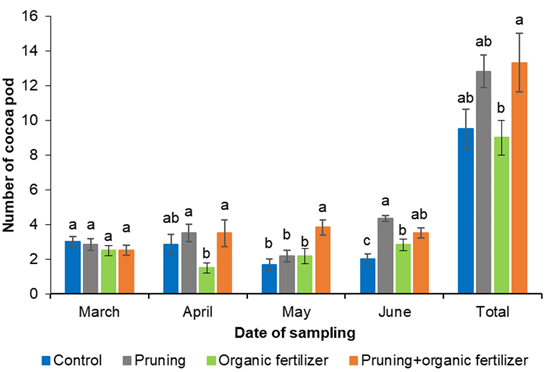
Figure 2 Effect of organic fertilization and pruning on the number of pods per tree in cacao plants in Nilo (Cundinamarca). Averages followed by different letters on each sampling date show statistical differences according to the LSD test (p <0.05). Vertical bars indicate the standard error (n=3, where n is a plot of 10 plants).
Pod length significantly varied between the treatments in March and June (Figure 3A). In March, the longest pods (24.8 cm) were obtained in the P treatment. In June, all pruned or/and fertilized trees produced pods that were significantly longer than the control pods (Figure 3A).
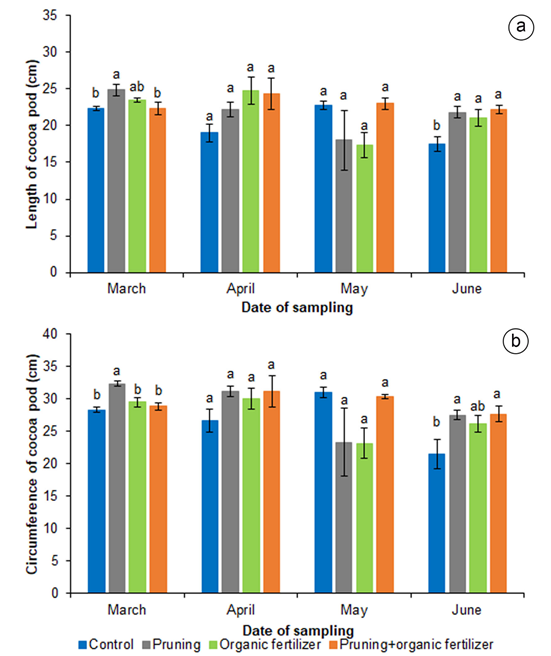
Figure 3 Effect of organic fertilization and pruning in cacao plants in Nilo (Cundinamarca). a) pod length; b) circumference of pods. Averages followed by different letters on each sampling date show statistical differences according to the LSD test (p <0.05). Vertical bars indicate the standard error (n=3, where n is a plot of 10 plants).
For pod circumference, statistical differences (p <0.05) between the treatments were found in March and June (Figure 3B). In the case of the first harvested pods (March), the largest circumference (32.33 ± 0.44 cm) was obtained with the P treatment. For June, this same treatment alone or in combination with organic fertilization (P + OF) generated the largest circumference of pods. The control plants, produced at the end of the 4-month harvest period pods of the smallest circumference (Figure 3B) and smallest length (Figure 3A).
For fresh weight of pods, a significant effect of the treatments was observed in April, May, and June (Figure 4A). At these harvest dates, the pruning and organic fertilization treatment (P+ OF) generated the most favorable response in terms of fruit weight. However, the total fresh weight of pods, accumulated after 4 months of harvest did not differ significantly between the treatments.
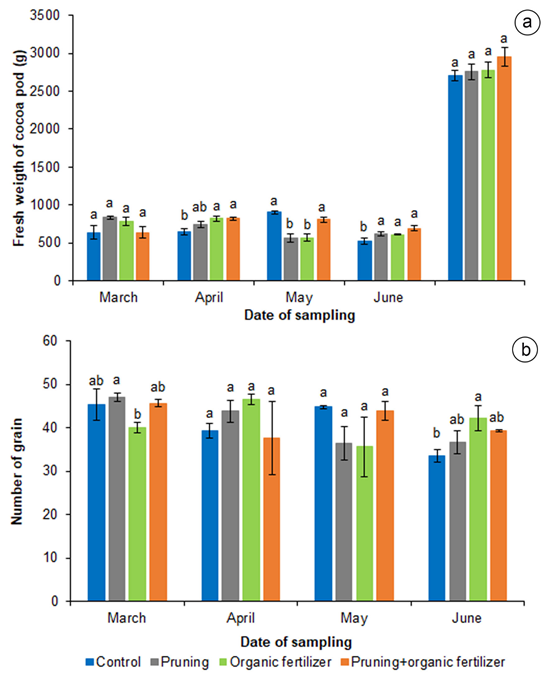
Figure 4 Effect of organic fertilization and pruning in cacao plants in Nilo (Cundinamarca). a) fresh weight of a cacao pod; b) the number of grains per pod. Averages followed by different letters on each sampling date show statistical differences according to the LSD test (p <0.05). Vertical bars indicate the standard error (n=3, where n is a plot of 10 plants).
In March, the pruning treatment resulted in 47 grains per pod, which was the highest number among the treatments (Figure 4B). In April and May, no statistical differences were observed for this variable; however, the highest number of grains per pod (46.5) was obtained with organic fertilization. In control plants, the pods had the highest number of grains (45.3) at the beginning of the harvest period (March), while the lowest number of grains (33.5) was observed at the final harvest (June) (Figure 4B).
Application of organic fertilizers could benefit the early stages of cacao growth (Acheampong et al. 2015; Fernández Lizarazo et al. 2016; Arthur et al. 2019). The application of cow manure, cacao pod husk compost, and sugar cane filter cake increased the soil contents of C, N, exchangeable Ca, and available P and Fe in soil under the cacao crop (Sugiyanto et al. 2008). Likewise, organic amendments in young cacao plants increased plant height, stem diameter, number of leaves, number of branches, and the mycorrhiza population (number of spores) (Adejobi et al. 2017). In adult cacao plants, applications of organic fertilizers increased the pod number per plant (Adejobi et al. 2019). In our study, organic fertilizers, especially when combined with pruning, in general had a positive effect on the number of pods per tree, pod circumference, length and weight, and bean yield (Figures 2-5).
Dry weight of cacao beans. For dry weight of beans, the differences between the treatments were observed at all sampling moments, except in March (Figure 5). From April to June and for the total bean weight, the treatments OF and P + OF produced the most favorable effect on the increment of seed yield. At the end of the experiment, the P+OF trees yielded almost 15 % more of the total dry bean weight as compared to the control.
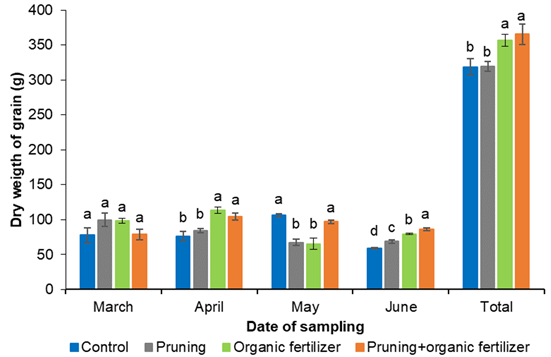
Figure 5 Effect of organic fertilization and pruning on the dry weight of cacao beans in Nilo (Cundinamarca). Averages followed by different letters on each sampling date show statistical differences according to the LSD test (p <0.05). Vertical bars indicate the standard error (n=3, where n is a plot of 10 plants).
For several variables, such as pod numbers per tree (Figure 2), pod fresh weight (Figure 4A), and dry weight of beans (Figure 5), no differences were found between the treatments with fertilizer applications for the first month of harvest (March). This could be due to the insufficient time for organic fertilizer mineralization, which resulted in no differences for the initial period of harvest. For total bean harvest, depletion of nutrient reserves in trunks, leaves and/or roots might be the reason for low bean weight in the pruning treatment P and control, while the application of organic fertilizers increased the total bean yield with or without pruning (Figure 5).
The positive effect of mycorrhizas on cacao growth and yield was also shown previously, making organic fertilizers and mycorrhizas an important amendment in the cultivation of organic cacao (Tuesta-Pinedo et al. 2017). In the Philippines, the joint application of biochar and arbuscular mycorrhizas improved height, stem diameter, leaf dry weight, and accumulation of N and P in 15-month-old cacao plants (Aggangan et al. 2019).
The treatments positively affected pod morphometry, as compared to control plants, which produced the smallest pods of the lowest weight, except in May (Figures 3 and 4A). The correlation between the pod volume and fresh weight is well established in cacao, with heavier pods having the larger volume (Thondaiman & Rajamani, 2014).
In cacao, the number of grains per pod has very high heritability; and, thus, it depends on the genotype (Cilas et al. 2010). At the same time, this trait varies depending on external factors, including temperature (Daymond & Hadley, 2008), pollination rate (Cilas et al. 2010), and availability of mineral nutrients (Loureiro et al. 2016). According to Daymond & Hadley (2008), the assimilation of nutrients and bean number are the determinants of final pod size in cacao. Inadequate mineral nutrition of cacao, such as deficiencies of nitrogen (Da Silva Almeida et al. 2014) and boron (Lachenaud, 1995), frequently results in a smaller number of grains per pod. Therefore, in our study, without an additional N supply from the compost, the number of grains could be lower because ovule fertilization was deficient and fewer grains were formed, such as was observed in June (Figure 4B). As consequence of a lower number of grains per pod, the pods would have slower growth, resulting in smaller length, circumference, and fresh weight of pods (Figures 2-4).
The number of grains directly influence the pod size in cacao, with pods becoming bigger with a high number of grains (Daymond & Hadley, 2008). The grains are strong sinks attracting high amounts of sucrose from the mother plant and, as consequence, the fruit husk receives more nutrients, and the fruit becomes larger (Van der Knaap & Østergaard, 2018). In addition, the seeds emit auxins into the fruit tissues, so with greater number of seeds, a fruit becomes larger and heavier (Balaguera-López et al. 2020). Although this trait depends on the genotype, the larger bean weight could also be associated with heavier pods in cacao (Santos et al. 2012). This was observed in the present study, with a positive correlation (R=0.748) established between the pod weight and the seed weight (Table 1).
Correlation analysis between the variables. Correlation analysis revealed the presence of significant correlations between the number of pods, the fresh weight of pods and the relative chlorophyll contents in both March and June (Table 1). A negative correlation (R=-0.618) was found among the foliar chlorophyll contents in June (end of the harvest period) and the number of pods per tree. A positive correlation (R=0.748) was obtained between the fresh weight of pods and the dry weight of beans. No correlation was found between the relative chlorophyll contents and the bean dry weight (Table 1).
In general, cacao pods tend to be larger and heavier with adequate N supply during pod formation (Snoeck et al. 2016). A sufficient supply of N increases the number of grains per pod, number of fruits per plant, and weight of grains per pod (Da Silva Almeida et al. 2014). In our study, the positive effect of N-containing compost on bean weight was observed, with the OF+P treatment increasing the total dry weight of beans per tree by 15 % as compared to unfertilized controls. In general, these data indicated the practical utility of compost application and pruning to increase the bean dry weight in old cacao trees.
According to our study, the application of organic fertilizers and pruning increased the length and circumference of cacao pods. A positive correlation (R=0.748) was obtained between the fresh weight of pods and the dry weight of beans. At the end of the harvest, the relative chlorophyll contents in leaves negatively correlated with the number of pods per tree (R=-0.618). Pruning and organic fertilization increased the total dry weight of beans per tree at almost 15 % and, therefore, could be used to increase bean yield in organic cacao production in Cundinamarca department.















